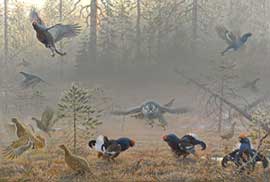
Plate 69 |
|
Perceiving an Annual Ritual
The Narrative
Black Grouse (Tetrao tetrix), also called blackcocks, appear in paintings by two artists. In one[not shown here], David Klöcker Ehrenstrahl portrays a habitat in which he could observe the birds doing something remarkable. The grouse have moved out from their sheltered roosting spots in the wood- land to their traditional mating grounds, or lek, and formed a mating aggregation in the open where the assembled birds could easily see one another and where Ehrenstrahl could easily see them. Ehrenstrahl records the fervor of the lek as it might be captured on film, but each element of his painting remains in focus and can be studied separately. Vadim Gorbatov also records a Black Grouse lek, but he ratchets up the fervor, showing all but the thoroughly engaged central contestants fleeing the swooping approach of a Northern Goshawk (Accipiter gentilis) (Plate 69).
The Role of Science Art
Although Ehrenstrahl painted his lek more than 300 years ago, we could conceivably see one in the same spot today, for every spring Black Grouse return to the same sites to form mating aggregations. Up to 200 males, but usually groups of 10–40, hold territories at a single, noisy, frantic lek, raising their
page 2--> |

